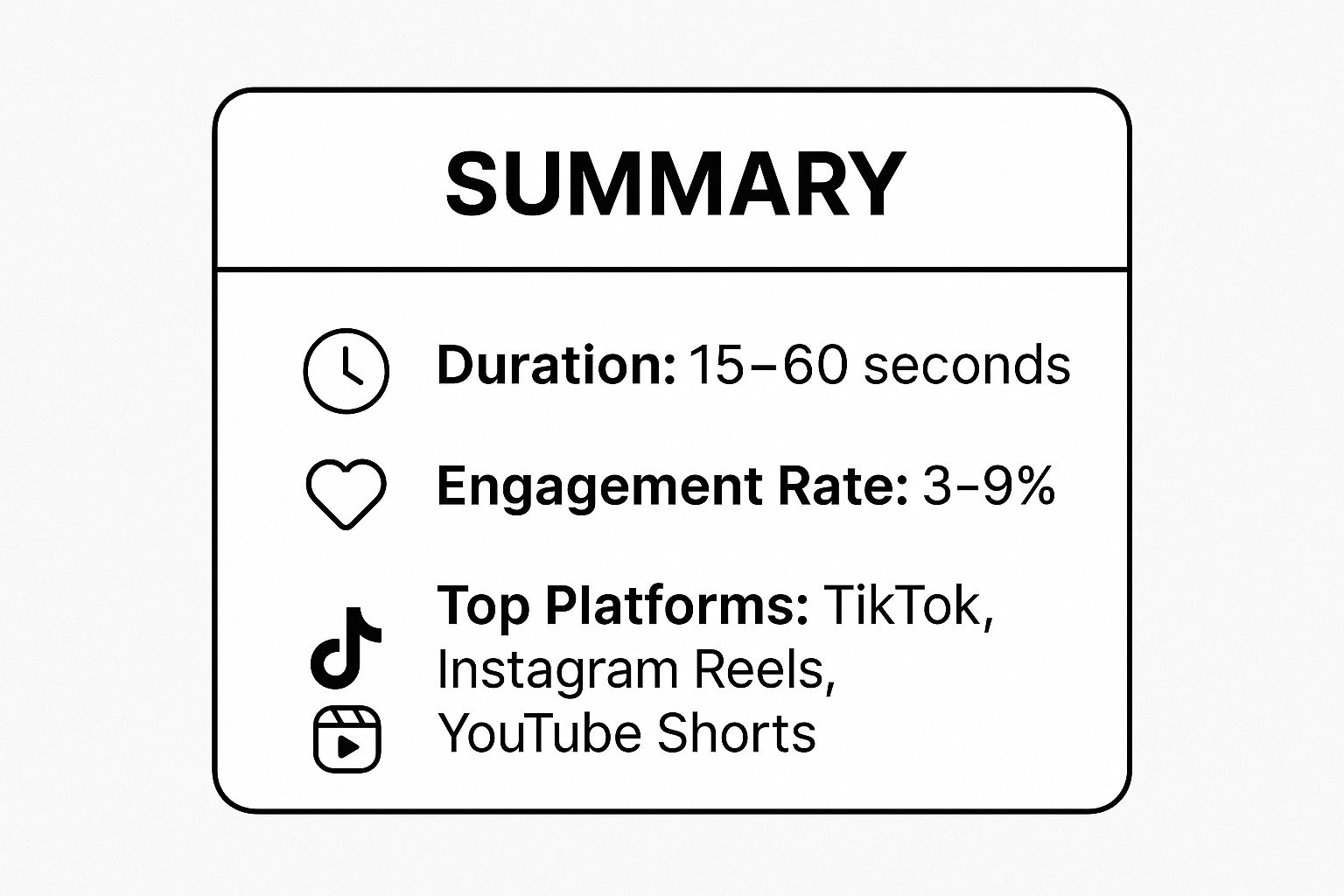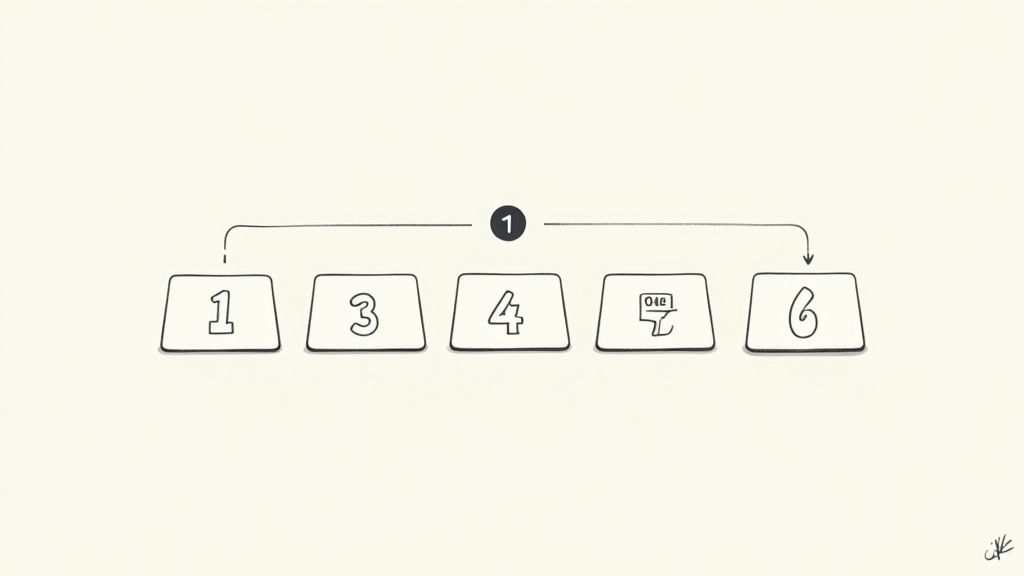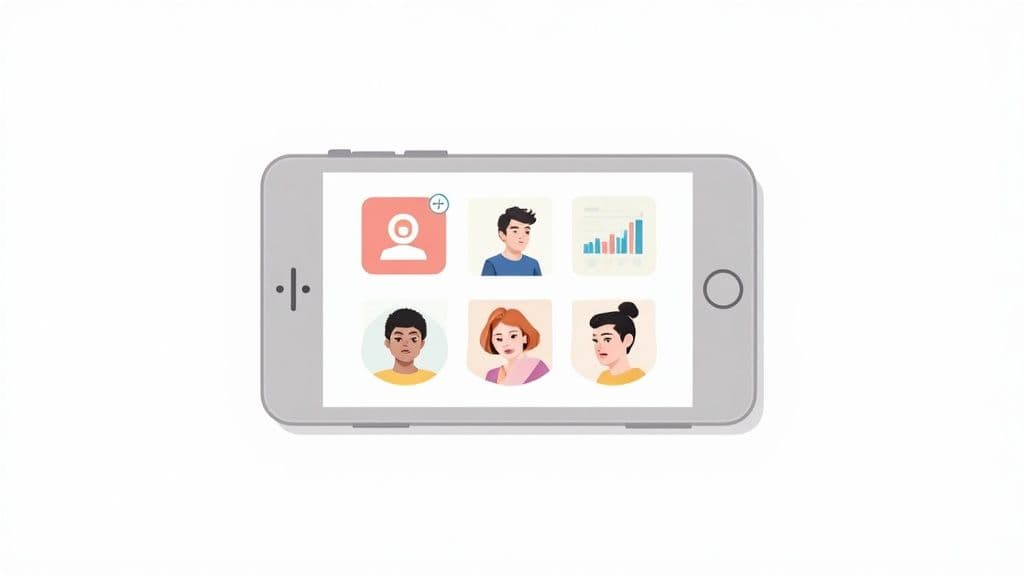In the fast-paced world of social media, simply posting isn’t enough. The difference between a forgotten post and a viral sensation often comes down to one thing: choosing the right format for your message. Understanding the different Types of Social Media Contents is crucial for capturing attention, driving engagement, and achieving your marketing goals. To stay ahead, marketers must also constantly analyze what types of content are popular on social media by tracking the latest social media marketing news and research from top industry authorities. For an overall framework to guide your posting, review these content creation best practices.
This guide moves beyond generic advice to provide a tactical breakdown of the most impactful content formats available today. We will explore the specific use cases, best practices, and real-world examples for each type, empowering you to make informed decisions for your brand or business. To truly master content that converts, it’s essential to integrate these types into overall powerful social media marketing strategies. This list is your blueprint for elevating your social media presence from mundane to magnetic, ensuring every piece of content you create works harder for you. Let’s dive into the formats that will define success.
1. Short-Form Video Content
Short-form video has become one of the most dominant and effective types of social media contents. This format consists of brief, highly engaging videos, typically between 15 and 60 seconds long. Designed for rapid consumption on mobile devices, these clips use a powerful combination of music, text overlays, and quick-cut editing to capture and hold viewer attention almost instantly.This format is also ideal for a content repurposing strategy, turning a single piece of footage into dozens of other assets.
Platforms like TikTok, Instagram Reels, and YouTube Shorts have propelled this format into a social media powerhouse. Its success lies in its ability to tell a compelling story or share valuable information in a fun, digestible, and shareable package.
Why It Works So Well
Short-form video thrives because it aligns perfectly with modern content consumption habits. The fast pace and algorithm-driven discovery feeds keep users engaged for extended periods, making it an incredibly effective tool for building brand awareness and community.
Brands like Duolingo leverage this format perfectly, using their mascot in comedic skits on TikTok to create a relatable and memorable brand personality. Similarly, Gymshark shares quick workout tutorials and motivational clips that provide immediate value to their fitness-focused audience.
How to Implement Short-Form Video
Success with short-form video requires a strategic approach. It’s not just about creating a short clip; it’s about making every second count.
- Hook Viewers Fast: You have less than three seconds to stop a user from scrolling. Start with a strong visual, a provocative question, or a surprising statement.
- Use Trending Audio: Incorporating trending sounds and music can significantly boost your video’s visibility and help it get discovered by new audiences.
- Prioritize Accessibility: Always add captions. Data shows a vast majority of social videos are watched with the sound off, so captions ensure your message lands regardless.
- Leverage Platform Features: Use native tools like TikTok’s Duet and Stitch or Instagram’s Remix features to engage with other creators and participate in viral trends.
The following infographic highlights the core stats that define this powerful content format.

This data clearly shows why short-form video is a key part of any social media strategy: its brief duration is perfectly suited for high engagement rates across today’s top platforms.
2. Live Streaming
Live streaming is a dynamic and interactive format that ranks among the most engaging types of social media contents. It involves broadcasting real-time video to an audience, creating an unedited and authentic connection. This format allows viewers to participate directly through live comments, reactions, and questions, fostering a strong sense of community and immediacy.

Platforms like Instagram Live, Facebook Live, YouTube Live, and Twitch have made this format accessible to everyone. Its power lies in its raw, unfiltered nature, which builds trust and allows for immediate feedback and two-way conversations that pre-recorded content cannot match.
Why It Works So Well
Live streaming capitalizes on the fear of missing out (FOMO) and the human desire for genuine connection. The unscripted environment makes the host feel more approachable and trustworthy, leading to higher engagement rates and deeper audience relationships.
For example, Sephora uses live streams for interactive beauty tutorials where experts answer customer questions in real time. Similarly, NASA captivates a global audience with live broadcasts of rocket launches and space missions, offering a front-row seat to historic moments.
How to Implement Live Streaming
A successful live stream balances preparation with spontaneity. The goal is to create a seamless experience that encourages viewers to stick around and participate.
- Promote in Advance: Announce your live stream 24-48 hours ahead of time to build anticipation and ensure your audience knows when to tune in.
- Prepare and Test: Check your equipment, internet connection, and lighting beforehand. Have a list of key talking points ready but be prepared to deviate and interact.
- Engage Actively: Address viewers by name, respond to their comments, and ask questions to keep the conversation flowing and make them feel involved.
- Include a Clear CTA: Whether you want viewers to visit a website, subscribe, or purchase a product, include clear call-to-action prompts throughout the stream.
3. Carousel Posts
Carousel posts are a versatile and powerful example of the different types of social media contents available to creators. This format allows you to combine multiple images or videos into a single, swipeable post. This creates an interactive experience, encouraging users to spend more time engaging with your content as they slide through each piece.

Popularized by Instagram and now widely used on LinkedIn and Facebook, carousels are perfect for storytelling, step-by-step tutorials, and breaking down complex information into digestible slides. Their success comes from their ability to deliver significant value and depth in a compact format.
Why It Works So Well
Carousels excel because they increase the time a user spends on a post, a key metric that social media algorithms favor. This extended interaction often leads to higher reach and engagement compared to a single static image.
Brands like Canva use this format to share design tips and mini-tutorials, providing immediate value to their audience. Similarly, HubSpot breaks down marketing data into easy-to-read graphics across multiple slides, making complex statistics accessible and shareable.
How to Implement Carousel Posts
A successful carousel guides the user on a clear journey from the first slide to the last. Each slide should build upon the previous one to tell a cohesive story.
- Create a Compelling First Slide: Your first image or video must be captivating enough to make users want to swipe. Think of it as the cover of a book.
- Encourage the Swipe: Use visual cues like arrows or text prompts like “Swipe to see more” to guide users through the content.
- Maintain Visual Cohesion: Keep your branding, fonts, and color palette consistent across all slides to create a professional and polished look.
- End with a Call-to-Action: The final slide is the perfect place to ask your audience to comment, save the post, or visit a link in your bio.
4. User-Generated Content (UGC)
User-Generated Content (UGC) is one of the most powerful types of social media contents, referring to any content created by customers or community members rather than the brand itself. This includes reviews, testimonials, photos, and videos featuring a company’s products or services. It acts as authentic social proof, transforming satisfied customers into brand advocates.
Platforms like Instagram, TikTok, and X (formerly Twitter) are hubs for UGC. Its immense value comes from its authenticity; consumers inherently trust recommendations from peers far more than they trust branded advertising. UGC provides a steady stream of genuine, relatable content that builds community and deepens brand loyalty.
Why It Works So Well
UGC thrives because it fosters a sense of trust and community. When potential buyers see real people enjoying a product, it validates their purchasing decision and makes the brand feel more human and approachable. It’s a scalable way to generate diverse content while celebrating the people who support your brand.
GoPro has built its entire marketing strategy around breathtaking adventure videos submitted by its users. Similarly, Apple’s #ShotOniPhone campaign showcases the incredible quality of its camera through the eyes of its customers, creating a visually stunning and highly persuasive content library.
How to Implement User-Generated Content
Encouraging and curating UGC requires a thoughtful and engaging approach. The goal is to make it easy and rewarding for your audience to share their experiences.
- Create a Branded Hashtag: Develop a simple, memorable, and unique hashtag for your campaign, like Starbucks’ #RedCupContest, to easily track and find submissions.
- Always Ask for Permission: Before reposting any user’s content, reach out and ask for their permission. It’s a crucial step for respecting your community and avoiding legal issues.
- Credit Creators Prominently: When you share UGC, always tag and credit the original creator in your caption. This shows appreciation and encourages others to participate.
- Incentivize Participation: Offer motivation through contests, giveaways, or by featuring top submissions on your profile. A simple spotlight can be a powerful reward. Effective social media strategies examples on postiz.com often highlight how to properly incentivize and manage UGC campaigns.
5. Stories and Ephemeral Content
Ephemeral content, commonly known as “Stories,” is another one of the most powerful types of social media contents. This format features photos and videos that disappear after 24 hours, creating a sense of urgency and encouraging followers to check in frequently. Displayed in a full-screen, vertical format, Stories allow for more authentic, behind-the-scenes content that doesn’t need to be as polished as a permanent feed post.
Pioneered by Snapchat and popularized by Instagram, Facebook, and even LinkedIn, this format’s temporary nature lowers the barrier to creation. It provides a high-visibility space at the top of the feed for brands and creators to share timely updates, interactive polls, and casual moments.
Why It Works So Well
Stories thrive on the psychological principle of FOMO (Fear Of Missing Out). Because the content is temporary, users feel a natural pull to view it before it’s gone. This leads to higher, more consistent engagement and keeps a brand top-of-mind.
Netflix masterfully uses Instagram Stories to build hype for new releases with interactive quizzes and countdown timers. Similarly, fashion brands like Fashion Nova announce new product drops and host influencer takeovers in their Stories, driving immediate traffic and sales through urgent, limited-time calls to action.
How to Implement Stories and Ephemeral Content
A successful Stories strategy is built on consistency and interaction. It’s about creating a daily conversation with your audience, not just a one-way broadcast.
- Be Consistent and Frequent: Post several times a day to stay at the front of your followers’ Stories feed. Understanding the best times to post an Instagram Story can further amplify your visibility.
- Use Interactive Stickers: Leverage polls, quizzes, question boxes, and sliders. These features are simple ways to boost engagement and gather valuable audience feedback.
- Mix Up Your Content: Don’t just post promotions. Share behind-the-scenes glimpses, user-generated content, quick tutorials, and team takeovers to keep your content fresh and relatable.
- Save Key Content to Highlights: Use the “Highlights” feature to save your most valuable or informative Stories to your profile, turning temporary content into a permanent resource.
6. Educational and How-To Content
Among the most valuable types of social media contents, educational content positions a brand or creator as a trusted authority. This format focuses on teaching skills, sharing knowledge, or solving specific problems for the audience through tutorials, step-by-step guides, and explainer videos. Its goal is to provide genuine, actionable value, which in turn builds credibility and loyalty.
Platforms like YouTube, Pinterest, and Instagram are ideal for this format, allowing creators to break down complex topics into digestible pieces. By answering the audience’s most pressing questions, educational content fosters a strong sense of community and becomes a go-to resource.
Why It Works So Well
Educational and how-to content is effective because it directly addresses user intent and pain points. People actively search for solutions and information on social media, making this format highly discoverable and shareable. It has a long shelf life, often remaining relevant and driving traffic long after its initial posting.
Brands like HubSpot excel at this, offering comprehensive marketing guides and tutorials that empower their audience. Similarly, Tasty’s quick-cut recipe videos on Instagram provide immediate value by showing viewers exactly how to create a meal, making the process look simple and achievable.
How to Implement Educational and How-To Content
Creating effective educational content requires understanding your audience’s needs and presenting information clearly. The key is to be helpful, not just promotional.
- Address Common Questions: Start by identifying the most frequent questions or pain points your audience faces. Use tools like AnswerThePublic or browse forums in your niche.
- Break It Down: Deconstruct complex topics into simple, bite-sized steps. Use visuals, short videos, or carousels to make the information easy to follow.
- Use Clear, Jargon-Free Language: Speak in a way that your target audience will understand. Avoid overly technical terms unless you are explaining them.
- Include Visual Demonstrations: Show, don’t just tell. Screen recordings, video tutorials, and step-by-step images are incredibly effective for demonstrating a process.
7. Memes and Humor Content
Memes and humor-based posts are among the most shareable types of social media contents. This format leverages relatable jokes, cultural references, and trending templates to create an immediate emotional connection with an audience. Memes are typically images or short videos with text overlays that spread rapidly, evolving as they are shared across social networks.

When executed well, this content humanizes a brand, making it appear more authentic and approachable. It taps into shared online experiences, fostering a sense of community and driving massive engagement through likes, comments, and shares.
Why It Works So Well
Humor breaks down barriers and makes brands memorable. It shows that there are real people behind the logo, people who understand internet culture. This format thrives on its high shareability, turning followers into brand advocates who spread your content organically.
Brands like Wendy’s have built an entire social media persona around witty roasts and meme-savvy replies. Similarly, Duolingo uses its unhinged owl mascot in trending TikTok formats to create hilarious, viral content that resonates deeply with a younger audience and keeps the brand top-of-mind.
How to Implement Memes and Humor
Successfully using humor requires a deep understanding of your audience and a quick finger on the pulse of internet trends. It’s about being clever, not just funny.
- Know Your Audience’s Humor: Understand what they find funny. A joke that lands with Gen Z might not resonate with millennials or older demographics.
- Act Fast on Trends: Memes have a very short lifespan. To be effective, you need to jump on a trend while it is still relevant and popular.
- Stay True to Your Brand Voice: Your humor should feel authentic to your brand. Forcing a meme that doesn’t fit your identity will come across as cringeworthy.
- Give Your Team Creative Freedom: Empower your social media managers to be creative within established guidelines. The best humor often comes from spontaneous, in-the-moment ideas.
8. Influencer Collaborations and Partnerships
Influencer collaborations represent one of the most powerful and authentic types of social media contents. This format involves partnering with creators who have built a loyal and engaged audience in a specific niche. Content can range from sponsored posts and product reviews to full-scale co-created campaigns, all designed to leverage the creator’s credibility and reach.
Platforms like Instagram, TikTok, and YouTube are the primary channels for these partnerships. The format’s power comes from its ability to introduce a brand or product to a new audience through a trusted, third-party voice, making the promotion feel more like a genuine recommendation than a traditional advertisement.
Why It Works So Well
Influencer marketing thrives on trust and authenticity. When a creator their audience respects recommends a product, it cuts through the noise of conventional advertising. This approach allows brands to tap into pre-built communities and connect with potential customers in a meaningful way.
Brands like Gymshark built their empire on this strategy, collaborating with fitness influencers to showcase their apparel in authentic workout settings. Similarly, Dunkin’s partnership with TikTok star Charli D’Amelio created a viral sensation, driving massive sales and brand awareness by integrating seamlessly into her content.
How to Implement Influencer Collaborations
A successful influencer partnership is built on clear communication and strategic alignment. It’s about finding the right partner, not just the one with the most followers.
- Align on Audience: Choose influencers whose followers match your target customer demographic. Prioritize their engagement rate and audience connection over a large follower count.
- Grant Creative Freedom: Provide a comprehensive brief with clear goals, but allow the creator to produce content in their authentic voice. Their audience follows them for their unique style.
- Establish Clear KPIs: Set your success metrics upfront. Whether it’s engagement, website clicks, or sales, use unique tracking links or discount codes to measure each influencer’s impact.
- Ensure Full Disclosure: Comply with advertising standards by ensuring all sponsored content is clearly marked with hashtags like #ad or #sponsored. Transparency builds trust with the audience. For more specific platform tactics, you can learn more about how to set up a collaborative post on Instagram.
This strategic approach turns a simple promotion into a powerful endorsement, driving both brand affinity and measurable results.
9. Polls, Quizzes, and Interactive Content
Interactive formats like polls and quizzes are essential types of social media contents that turn passive viewers into active participants. Rather than just consuming information, users are invited to share their opinions, test their knowledge, or discover something about themselves. This creates a powerful two-way conversation between a brand and its audience.
Platforms like Instagram Stories and Twitter have made polls a native feature, while sites like BuzzFeed built empires on the back of viral personality quizzes. These formats succeed by being low-effort for the user but high-value for engagement, as they tap into the human desire to share and be heard.
Why It Works So Well
Interactive content boosts engagement metrics significantly because it requires an action: a click, a vote, or a choice. This participation not only increases visibility through algorithms but also provides brands with direct, valuable feedback and audience insights.
Spotify’s annual “Wrapped” campaign is a masterclass in this, turning personal listening data into a shareable interactive story. Similarly, Starbucks often uses polls on Instagram to let customers vote on future drink flavors, making their audience feel like a valued part of the brand’s decision-making process.
How to Implement Polls, Quizzes, and Interactive Content
A successful interactive strategy is about asking the right questions in the right format. It should be both entertaining for the user and insightful for your brand.
- Keep It Simple and Quick: Design polls and quizzes to be answered in seconds. Use clear, concise questions and straightforward options like the “this or that” format.
- Create Shareable Results: For quizzes, focus on creating results that people will want to share. Positive, relatable personality outcomes are highly effective.
- Share and Discuss the Outcome: Don’t just post a poll and forget it. Follow up by sharing the final results and thanking your audience for participating. This closes the loop and encourages future engagement.
- Gamify the Experience: Add a layer of fun by creating trivia games, challenges, or a quiz series that encourages users to come back for more.
Types of Social Media Content Comparison
| Content Type | Implementation Complexity 🔄 | Resource Requirements ⚡ | Expected Outcomes 📊 | Ideal Use Cases 💡 | Key Advantages ⭐ |
|---|---|---|---|---|---|
| Short-Form Video Content | Medium – requires trend awareness and editing skills | Low to Medium – simple production, built-in tools | High engagement (3-9% avg), viral potential | Quick attention capture, brand awareness, mobile audiences | Highest engagement, cost-effective, strong organic reach |
| Live Streaming | High – real-time setup and commitment required | Medium – good lighting, internet, promotion | Very High engagement (6x regular videos) | Q&A, tutorials, community building, events | Authenticity, immediate interaction, strong community ties |
| Carousel Posts | Medium – multi-slide content creation | Medium – multiple images/videos, cohesive design | Increased engagement (1.4x single posts) | Storytelling, tutorials, before/after showcases | Extended engagement, versatile storytelling, algorithm favored |
| User-Generated Content (UGC) | Low to Medium – sourcing and curating content | Low – relies on community contributions | Builds trust & loyalty, 161% boost in conversion | Social proof, brand advocacy, authenticity | Highly trusted, cost-effective, diverse perspectives |
| Stories and Ephemeral Content | Low to Medium – frequent posting and interactive elements | Low – simple mobile content creation | High visibility, 70% completion rate | Behind-the-scenes, timely updates, casual engagement | Urgency driven, algorithm-independent prominence, easy creation |
| Educational and How-To Content | Medium to High – requires expertise and structured content | Medium to High – research, visuals, editing | High saves/bookmarks, long-term trust | Tutorials, guides, SEO, thought leadership | Builds authority, evergreen, drives quality traffic |
| Memes and Humor Content | Low to Medium – creative but trend-sensitive | Low – minimal resources, quick creation | Very High viral potential | Relatable engagement, brand personality | Highly shareable, cost-effective, emotional connection |
| Influencer Collaborations | High – complex coordination and vetting | High – influencer costs and management | Strong brand awareness, measurable ROI | Product promotion, audience targeting | Authentic trust, scalable reach, expert content creation |
| Polls, Quizzes, Interactive Content | Low to Medium – content design and platform use | Low – uses native platform tools | 2x engagement boost, 70-80% completion rate | Audience feedback, engagement, data collection | High engagement, valuable insights, builds community |
To accurately gauge performance and measure the true impact of these Types of Social Media Contents, you must monitor key social media engagement metrics on an ongoing basis.
Putting Your Content Plan into Action
You have explored the rich and diverse landscape of social media content, from short-form video to live streams and user-generated content. We’ve shown the strategic application of each format to gather research, educate, and engage.
The most critical takeaway is that a successful social media presence is not about mastering every single one of these formats overnight. Instead, it’s about strategic selection and consistent execution. The goal is to build a content mix that feels authentic to your brand, provides genuine value to your followers, and directly supports your business objectives
Your Actionable Next Steps
To turn this knowledge into tangible results, don’t get overwhelmed. Start with a focused, manageable approach that builds momentum. Here are your immediate next steps:
- Audit and Analyze: Look at your current social media performance. Which formats are already working for you? Where are the biggest gaps and opportunities? Identify the content types your audience already engages with the most.
- Select Two New Formats: Choose just two formats from this list that you haven’t tried or have underutilized. Perhaps it’s launching your first live Q&A session or creating a weekly educational carousel. Focus on mastering these before adding more to the mix.
- Plan and Schedule: Create a simple content calendar for the next month. Intentionally integrate your two new formats alongside your existing content. Planning ahead ensures you maintain variety and consistency without last-minute scrambling.
- Measure and Iterate: After a month, review the data. Did the new formats drive engagement? Did they resonate with your followers? Use these insights to refine your strategy for the following month, either doubling down on what worked or testing a different approach.By understanding your social media engagement metrics, you can make smarter decisions.
By embracing this iterative process, you’ll discover the optimal content recipe for your unique brand and audience. This isn’t just about posting more; it’s about posting with purpose and precision. Mastering these different types of social media contents empowers you to connect with your audience on multiple levels, building a stronger, more resilient brand that can adapt to the ever-changing digital world.
Ready to streamline your content creation and bring your new strategy to life? With Postiz, you can ideate, design, schedule, and analyze all these diverse types of social media contents from a single, intuitive platform. Stop juggling multiple tools and start building a more powerful, cohesive social media presence today with Postiz.





